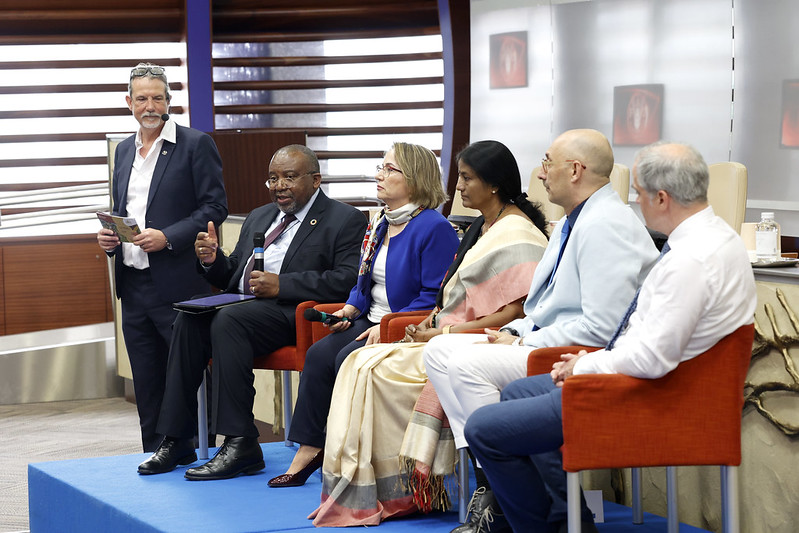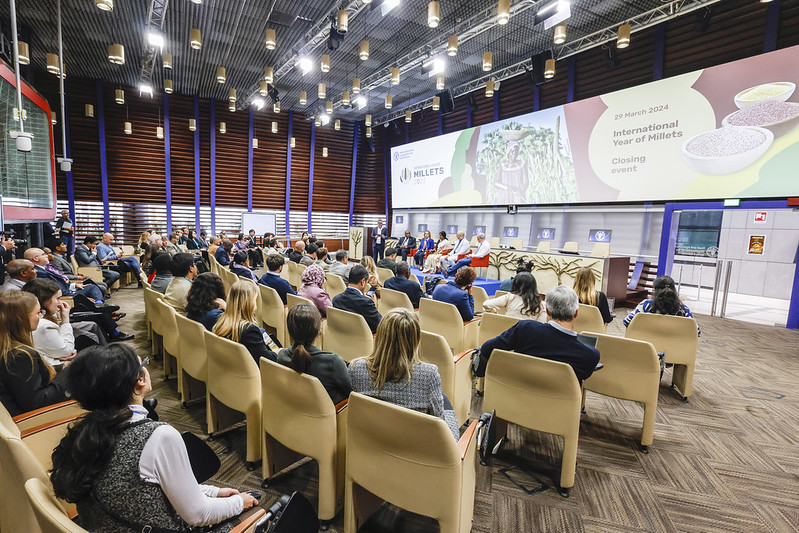Crop improvement holds promise to boost millets production in adverse growing conditions
Research and development depend on investment and policy support

©FAO/Riccardo De Luca
Advances in plant breeding technologies and value chains have enormous potential to boost sustainable millet production and consumer demand but must be backed by investment and policy support.
That was one of the key messages from researchers and other experts at the roundtable discussion on research and development for the millet sector held at FAO headquarters in Rome today (29 March) to mark the official closure of the International Year of Millets 2023.
In his opening remarks, Chikelu Mba, the Deputy Director of FAO’s Plant Production and Protection Division, said the Year had succeeded in raising awareness about these small grain dryland cereals but stressed the need to address weaknesses along their value chains. “We have been reminded that millets possess inherent traits that make them particularly suitable for low input production systems and enable them to adapt to the vagaries of climate change and variations,” Mba said.

©FAO/Riccardo De Luca
During her keynote address, Rebbie Harawa, the Director of the International Crops Research Institute for the Semi-Arid Tropics (ICRISAT) Africa Programme, said that partnerships are needed to enhance investments in research and development, influence policy and support millets value chains.
Harawa noted the various benefits of millets – from being climate-smart crops that require little inputs and sources of important nutrients – and new varieties are improving on the traits.
She said scientists at ICRISAT had used plant breeding techniques to develop Africa’s first biofortified, drought tolerant pearl millet variety, Chakti. As a source of iron, this biofortified pearl millet is important for women and children, she said.
ICRISAT is a world repository for the germplasm collections of eight different types of millets, and Harawa said it was important to safeguard these crops’ genetic diversity through support to national and international genebanks while working with farmers and Indigenous communities to strengthen community seed banks.
Panelist Fatma Sarsu, a senior plant breeder at the Center of Nuclear Techniques in Food and Agriculture, a joint initiative of FAO and the International Atomic Energy Agency, spoke about a research project on accelerated genetic improvement of dryland millets for climate change adaptation.
Sarsu said a great deal had already been achieved and there was a need to leverage interdisciplinary collaboration and partnerships to further develop millet breeding initiatives. “Research and development have not been explored as it needs to be,” she said. “We are working to improve millet production for food security.”
Through FAO and IAEA efforts, she said 62 millet varieties had been developed in 15 countries through mutation breeding and biotechnology.
Tara Satyavathi, the Director of the ICAR-Indian Institute of Millets Research, said high-yielding, disease-resistant millet varieties could increase yields and emphasized the need for the production and distribution of affordable, high-quality seeds to farmers.
She said the Institute had developed 270 varieties and was working to integrate millets into cropping systems while working with the private sector to create seed hubs to enhance farmers’ access to the inputs.

©FAO/Riccardo De Luca
Giovanni Dinelli is a researcher and coordinator of the European Union’s Great Life project at the University of Bologna. Great Life is experimenting with crop varieties that are more resilient to climate change challenges in Italy.
Dinelli said millets had been popular during the Middle Ages but had since been replaced by other crops. Great Life was encouraging farmers to move to climate-resilient crops like sorghum that require less water. He said sorghum was a good choice because it was less vulnerable to pathogens and could grow faster than maize.
Fritjof Boerstler, Senior Natural Resources Officer and the Global Coordinator of the Global Environment Facility-7 Impact Program on Sustainable Dryland Landscapes , highlighted how six participating countries in Southern Africa are coming together to address common management challenges in drylands through resilient farming systems.
Boerstler said it is important to interact with local forest and farm producer organizations and assess the needs and barriers at ground-level to ensure interventions are effectively meeting local demands.
In his closing remarks, Fenton Beed, Senior Agricultural Officer, in FAO’s Plant Production and Protection Division, said the event had invigorated knowledge about millets and that they were at the heart of a sustainable future for food security.
The roundtable was held ahead of the closing ceremony of the International Year of Millets 2023.
The Year has not only raised awareness about the sector,but encouraged greater investment and more policies to promote sustainable crop production, with minimal inputs under changing climatic conditions.
Among the successful initiatives were the Millets Recipe Book, the Chefs Challenge, the Photo Contest, and Stories from Millet Champions.

